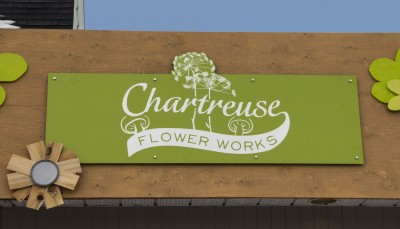Becoming an entrepreneur
Toupin signed up for the course. As part of the curriculum, she had to brainstorm a variety of business concepts. Her research for this purpose eventually led her to signage.
“We had to come up with our own ideas, research them and then pitch them in the classroom,” she explains. “You had to think about who would buy your product. One of my ideas involved putting paintings and photos into frames that were backlit with light-emitting diodes (LEDs) for outdoor use, but as I researched the concept further, it wasn’t clear I would find enough customers.”
When she stumbled upon aluminum composite-based signs, however, she felt there was a greater opportunity to serve a broader market, including both businesses and private homeowners. This was key, as her course required her to forecast at least one year’s worth of work in her business plan.

In late 2012, Toupin landed her first business-commissioned signage project. Black Prince Winery in Picton, Ont., hired her to update its image on outdoor signage.
“I ordered some samples of composites and tested them out, to see exactly how they would look when turned into outdoor signs, both in colour and in black and white,” she says. “When I brought the idea to class and pitched it, we discussed it and came up with the outdoor signage market. Everyone said it would be a very good fit for me.”
Toupin finalized her business plan in July 2012 and incorporated under her own name the following month.
Material matters
One of the reasons Toupin leaned toward using the composite materials—with two prepainted aluminum sheets bonded to a solid polyethylene (PE) core—was their durability for outdoor installations. Kingston is prone to relatively severe weather conditions, especially lake-effect wind and snow, given its proximity to Lake Ontario.
“I loved the material’s low weight and sturdiness,” she says. “It could withstand the fluctuations in weather, with wind and snow bouncing off the signs. The ink adhesion is great. And it offers several fabrication options, including straight cutting, rounding and forming into three-dimensional (3-D) shapes. It can be bent, shaped and cut with curves.”
Going it alone as an entrepreneur, however, Toupin’s plan was to focus her time on running her business and designing pieces for her clients, rather than running an entire sign shop. In addition to the graphic design process itself, her tasks include travelling to meetings, ordering supplies, calculating quotes for clients, invoicing and shipping.
So, she looked into outsourcing the physical signmaking work.

This outdoor sign for a new flower shop in Kingston was produced on 3A Composites’ Dibond material with a brushed-silver finish.
“As I studied everything about how to make these products, I got in touch with a sign company in Toronto that outsources its cutting and found out who they were using,” she explains. “Now I use them to both print and cut my graphics. Next, I’m looking into laser etching and resins.”
She is also looking into substrates that allow graphics to be printed at higher resolution, as well as texture-finished composites that can be printed on both sides.
“There are lots of products in the sign industry I haven’t seen yet,” she says. “I’m not finished learning. I love to find out about all of the new technologies that are making the process of signmaking easier and better.”





